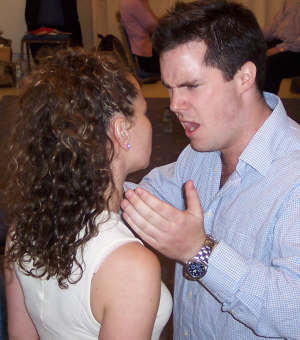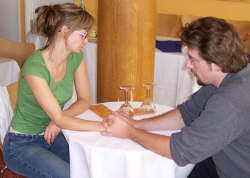Gina Peach and Giles Underwood in TFM, Cheltenham 2004
The Full Monteverdi – LIVE SHOW 2004-7
In 2002, opera director John La Bouchardière came to I Fagiolini with a dangerous idea about staging Monteverdi’s fourth book of madrigals. The live show was launched at the Cheltenham Festival in 2004. It closed with a run at the Lincoln Center, New York, in 2007 – 88 performances later.
Breaking most of the rules about how this music is performed, The Full Monteverdi brought a new emotional depth to those experiencing this music live. With the audience situated among the singers, it was a uniquely physical, voyeuristic and compelling event that caused a sensation wherever it went.
“One of the most surprising music-theatre hits of the decade.” The Times
“Music-theatre doesn’t come more visceral than this.” The Independent
“An unforgettable evening.” The Guardian
“An extraordinary experiment in performance style.” The Independent on Sunday
“A moment in the lives of those present that will not easily be forgotten. I have rarely, if ever, seen an audience as rapt, as engaged with music as on that evening.” Early Music
“It is surely the closest one can get to being inside Monteverdi’s head, or inside the head of anyone who has loved and lost.” Early Music Review
“Nobody could leave the room without believing they had been privy to some sort of miracle of human endeavour. It was witchcraft.” The Daily Telegraph

Robert Hollingworth (Director of I Fagiolini) writes:
The Full Monteverdi was a dramatised account of (fairly unarguably) the greatest book of music for unaccompanied voices ever written, Monteverdi’s fourth book of madrigals from 1603. These powerful pieces (having little in common with most of their more gentle English cousins) demand passion, discipline and virtuosity from the singers and their expressive power is unmatched, as we have found when singing them in concert to a wide range of different audiences.
The Full Monteverdi began as a project in the mind of opera director John La Bouchardière (see below). He had an innovative idea of presenting the whole book, requiring it to be learnt by heart. He approached Harry Christophers of The Sixteen who pushed him our way. I was initially sceptical because of the technical and acoustical demands of the production but changed my mind after experimenting with it in a rehearsal space. It turned into the most demanding project we have ever undertaken.
Central to it was how to make the subject matter mean something to a contemporary listener. With an opera, you can sympathise with the characters. In a Schubert song-cycle you travel with the singer through very personal poetry. So with Monteverdi’s fourth book? As always with madrigals, the difficulty was how to bring the poetry alive and how to make believable a set of emotions expressed by five individuals simultaneously.
John La Bouchardière (concept and direction) writes:
The Full Monteverdi was a bit of an accident or a series of happy ones. From working in large opera houses, I had come to miss the close physical relationship between performers and the audience, I wanted the public feel the same visceral performance of singers that I knew from rehearsals. So I started looking for material that could be experienced without the barrier of an orchestra pit but, instead of thinking of where else one might place an orchestra, wanted to explore doing without it entirely.
No orchestra (or no accompaniment) meant a cappella, which was a comfortable world for me, after my chorister days, but was an exceedingly unlikely source of dramatic material. I had known Monteverdi’s Book IV for many years and so turned to this early in my search. Having always experienced the book as a single entity on record I sensed a dramatic arch to the collection, though it is doubtful that one was ever intended. The poems all concern the fate of abandoned lovers, so there was a definite subject too. The conceptual challenge, however, came in trying negotiate what seemed an implausible dead-end: when, in real life, do several different people utter something so intimate as “I love you, don’t leave me” as a group?
Some months later, I was sitting in a restaurant and noticed that several of those people at the tables around me were having variously unhappy evenings: to one side was a couple whose conversation had dried up the moment the waitress had taken away the menu; to another was a couple trying to suppress a heated conversation; and there was also a woman who appeared to have been stood up. It occurred to me that these people were at different points of a similar journey in this space and that, if they were synchronised, might utter the same words at the same time. Thus the restaurant became a space in which the multi-voiced madrigal could exist as polyphonic drama.
Only later, during discussions with Robert and then in workshop and rehearsal, did the most exceptional qualities of the project become apparent: the intimate proximity of the performers created an acutely voyeuristic experience for an audience which found itself trapped inside an agonisingly emotional, shifting surround-sound version of Monteverdi’s counterpoint. In modern restaurants, such music would only ever sit in the background: the tables had been turned.
Full cast:
Anna Crookes (soprano) with Pano Masti
Carys Lane (soprano) with Alan Mooney
Clare Wilkinson (mezzo) with Mark Denham
Nicholas Mulroy (tenor) with Katharine Peachey
Matthew Brook (baritone) with Anna Skye
Giles Underwood (bass-baritone) with Gina Peach
Eamonn Dougan sang baritone 2006-7 and James Oxley tenor in London and New York, 2007.
Funded in part by Arts Council England.
More on the Fourth Book (Robert Hollingworth)
The music of Monteverdi was one of the first things to interest me in early music. I had sung in performances of the 1610 Vespers as a boy and in my teens came across various Taverner Consort and Parley of Instrument recordings, the pure sound of which was so attractive. I developed a passion for his secular music, impressed by the larger-scale works with strings and the reams of virtuosic semiquavers portraying anger, one of his famous innovations.

He wrote six books of five-voice madrigals, a basic accompaniment being required for some of books V and VI. They spanned his entire creative life at the Gonzaga court in Mantua from the 1580s to his move to Venice in 1614, and they become increasingly demanding of the performer, requiring virtuosity of many different types. (He had at his disposal one of the new professional ensembles.)
More than all the other books, the fourth, published in 1603 after a gap of 11 years, breaks new ground. The dissonant writing upset one critic, yet other composers, Gesualdo notably, were to do stranger things to harmony. What makes Monteverdi stand out from his contemporaries (and after all the research of recent times into hitherto hidden composers, he still stands alone) is the emotionally direct power of his writing.
Technically speaking (for anyone interested) the basic diatonic harmony behind his music is simple. What is exceptional is the way he writes dissonance against this to create and dissipate tension which so perfectly expresses the meaning behind the words. If this sounds unhelpfully clinical, its effect is not – one just has to listen to a few bars and be caught up in the emotion to appreciate the effect. You don’t need to be a lighting designer to enjoy a Hitchcock movie.
Exactly the same processes are involved in his first opera, L’Orfeo, first performed only four years after the fourth book was published and without doubt the first great opera. It’s that same expressive use of harmony underpinning the inherently dramatic vocal writing that gives L’Orfeo such emotional clout.
If you think of Monteverdi, what is it you bring to mind? A sort of prototype Handel and Vivaldi? The grandeur of the Vespers? Italian passion in a safe early music sort of way?
By now it’ll be apparent that our approach to him is as a pioneering modernist – but the sweet sounds he writes are undeniable. His music has an awareness of sonority that makes the notes endlessly pleasurable to hear, a dangerous if attractive characteristic: Beecham warned of the danger of liking the noise music made rather than the music itself. Rather, this awareness of sonority is an extra layer, helping each chord and shape to speak in the most effective and sonorous way possible, heightening each effect.
The result? Music stripped away to ‘a nucleus of expressive intensity, leaving painful nerve-ends everywhere exposed to the force of emotion which revealed them – the new naturalism’ as James Weeks has called it. It’s fiercely modern, so trying to understand it by working backwards from Handel is unhelpful. Instead it’s the culmination of a current in Renaissance music which looked to colour every word.
- I was thinking that. Also @JolyonMaugham was (which carries a little more weight). https://t.co/pAu9emYdGd
- For my birthday I have done admin, walked dog, and rehearsed Walton with @The24choir https://t.co/jNTU2B3UIw https://t.co/LDhso8U9jS
- It's very reasonably priced and all those benefits.... https://t.co/DFJS8e9Dqw
